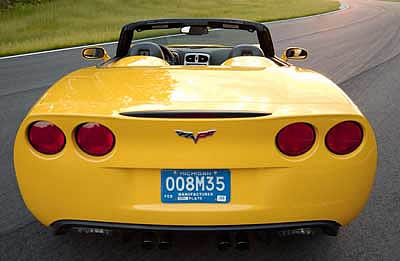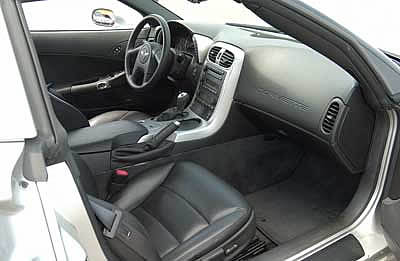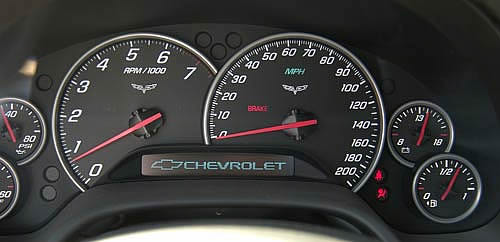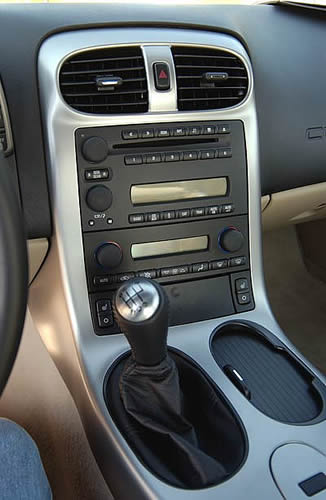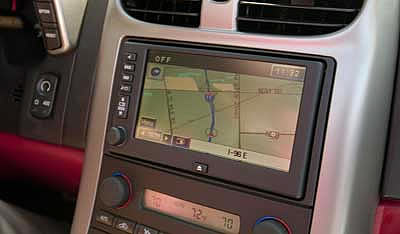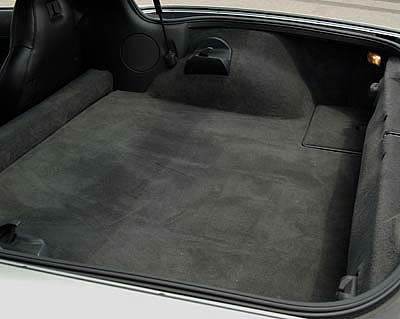C6, Naked and Exposed: Corvette Action Center's First Look at the 2005 Corvette - The Sequel: Finally, We Drive It! - Page 4 of 12
 |
 |
C6 Naked and Exposed - The Sequel: Finally...We Drive It!!! - Page 4 of 12
And, Talk to Some of the People who Built It
by Hib Halverson
Imagery by GM Communications, Richard Prince, U.S. Air Force and Sharkcom
©2005 Shark Communications
No use without permission
I also looked at the car from "dead-rear," as Peters suggested in our follow-up interview, and re-examined the little gray pup-spoiler-CHMSL thing, actually...I called it a "knicknack" in my January article; a wonder Peters didn't take a whack at me for that.
You can clearly see the dihedral that Tom and his people so much wanted to imply visually, but I'm still having trouble getting past the gray on a light-colored car. It's too bad that initial crash testing killed the all-lens spoiler. That would have looked pretty cool. Hopefully, based on the later crash tests Tom suggested, they'll put the all-lens CHMSL back on.
Also, back in the January 1st CAC story, I said that the C6's fender vents seemed too edgy. It might have been the lighting or the viewing distance (Back on Dec. 18, '03, I was looking at the car indoors), but, seen in daylight, from a little more of a distance, they've grown on me. I've changed my mind. I think the combination of the wheels, the wheel well shape and the vents at a slight angle, flowing off the wheel opening is pretty neat.
And then, we have the lights. Man, I'm liking those head lamps! I totally agree with Peters: having the interior of the light assembly body color really makes a difference and you can see that fender theme as it carries through the body-color lamp assembly.
If you buy a C6, here's my suggestion: park it out in the driveway, put your favorite lawn chair about 40 feet away and sip a glass of your favorite microbrew or fine wine while you take in the visual experience of enjoying the exterior design of the 2005 Corvette. I'm sure you'll discover some of those delightful, intriguing shapes and surfaces Tom Peters talks about.
C6 on the Inside
So what about the '05's interior? After standing in the sun, pondering the outside of 00001, I went and got a bottled water from one of the ever-present/ever-efficient "Shows and Shoots" employees, whom Chevy hires to keep we media wonks appropriately pampered with clean cars, snacks and cool drinks, then went back and sat in a C6.
A prime directive of the interior team was to give the cockpit a more upscale or "rich" look and feel. What drove Chevy to this more opulent philosophy? Its belief that Corvette customers and some of the media thought the C5 interior was "cheap".
I drove a lot of road test cars during the C5 years and I own an '04 Z06. Even after doing a "back-to-back" in my C5, then, two days later, these C6es, I still am not convinced the C5 interior is cheap. Conversely, it's not super plush, but I wouldn't want it that way. I like my performance car interiors a little utilitarian; somewhat stark, even. Instruments and controls need to be simple, functional, easy to use and the stereo needs to kick butt.
As for the interior in the new car? Well...it's new, different, better, but I don't get a strong feeling of having moved up-scale or of new-found affluence; I seem to only get that from the folks who pay me to write this stuff. I do like the "cleaner" look it has and, I'll admit: the cast-skin, foam-in-place material used on some soft trim surfaces, indeed, mimics the look and feel of padded leather. Those who believed the C5's interior to be cheap will feel more substantial in the new car's cockpit.
Oh yeah...the cast-skin, foam-in-place thing. We talked about that in January and, as GM said then, how it, "...has twice the life of conventional automotive soft trim, resists fading and minimizes the interior fogging which occurs as plasticizers migrate out of the material."
We were interested to learn more, so we contacted Keith Klobucar, a GM engineer who works with interior pieces. He told us, "The process used for the 'cast skin' on the Corvette Instrument Panel is as follows: A master model is made of the Instrument Panel surface covered with face goods. Corvette used real leather in order to provide the ultimate leather quality look and texture."
Tools are made from the wrapped, master model through a series of silicone casts and plaster mandrels. The end result is a nickel-shell tool that is a female version of the master model.
Urethane powder; a premium for Corvette, most instrument panels are made from vinyl powder; is placed in the the nickel-shell tool and heated until it liquifies. Then, the tool is rotated in various directions so the liquid completely covers the inside of the tool at the required thickness, usually around 1-mm. The tool cools and the urethane hardens into an instrument panel skin. The skin is removed from the tool and trimmed. This urethane casting process is why it is referred to as 'cast skin'.
The cast skin is placed in the bottom of a two-piece foam tool. The injection molded, structural portion of the instrument panel; a reinforced plastic part, called the 'instrument panel retainer' is placed into the upper portion of the foam tool. The tool is closed and two-part, urethane foam is injected between the instrument panel retainer and the cast skin. The foam provides the soft feel when the instrument panel surface is touched and also provides adhesion between the cast skin and instrument panel retainer.
The excess skin and foam are waterjet-cut away from the instrument panel retainer. Additional components are added to the cast skin, foam and retainer to finish building the system into a complete instrument panel.
The door panels are also made from cast skin with foam in place manufacturing. This was done to make a more luxurious interior and to match the IP to the door trim.
We're not going to know for a while if the "twice the life" thing will pan out, but this new material certainly does feel "rich" to the touch and its comfortable look and texture integrates nicely with those of the rest of the interior.
What I'm most fond of inside a C6 are not touchie-feelie or eye-candy items. They're functional. The improvements to the intstruments (larger size, better lighting) and the head-up display (more data options, brighter and more legible characters) are outstanding enhancements.
Another functional upgrade I took a liking to (almost instantly) is a revised gear shifter. Shift effort seems about the same as before, but the throw is shorter and there's a slight increase in an abstract quality some call "precision". GM acomplished this with revisions to the shifter, addition of bearings to the shift rails inside the Tremec T56 six-speed and revised synchronizer assemblies which reduced effort by 10%. This improvement is quite effective and probably eliminates the need for aftermarket shifters for all except hard-core racers and those who want a shifter just for the sake of modification.
Vehicle electronics nuts will welcome the addition of a GPS-driven, vehicle navigation system. I had this thing running for part of the ride. It was pretty cool to look down at the screen and see a little icon signifying the car on a line marked I-96. Nevertheless, I'm from the old school, ie: situational awareness and a good map so, if I were flipping open my checkbook to buy a 2005, I'm not sure if I'd select that RPO.
Also available is On-Star which, as far as I'm concerned, has one useful feature and that is automatic contact with On-Star (which, in turn, notifies the first-response agency with jurisdiction) if the airbags blow in a collision, otherwise, On-Star ain't any better than an average wireless phone and, compared to a driver initiating a 911 call directly, it's slower and more complex.
Because GM limited our time in these C6es and I spent most of the public road segments talking with people who designed and developed the cars, I did no sound system evaluation, but the system in C5 was pretty good and it's higly unlikely GM would step back from that.
On the subject of sound, it's impossible to not notice the results of Team Corvette's efforts in reducing interior noise, a problem which provoked the ire of many a C5 owner. Part of noise problem was the "second generation" EMT tire, which we'll discuss later in our ride-and-handing evaluation. The other part was the C5 interior's insufficient acoustic insulation package.
Other than the LS2 engine, which we'll also get to in a bit, the first dynamic quality of a 2005 most C5ers will notice is this decrease in road noise. It seems GM was listening to its customers on this issue but, that it took so long for the General to make an improvement, which should have happened back about 1998, is unfortunate. Ranting aside, the facts are: Team Corvette has done better...and quieter with C6.
We spoke to Larry Hartleip, a GM Development Engineer who works with Corvette interior noise issues and headed this "noise abatement" program.
Be it engine performance, ride-and-handling or interior noise, in today's automotive product development process, the first step is almost always exhaustive analysis which makes achivement of a program's goals faster, more efficient and less costly.
Hartleip's group used "statisical energy analysis" (SEA) to determine what the sound's source, frequency and amplitude were and from what direction and through what medium it came. Analysis determined the problem was caused by a stiff EMT tire casing, coarse pavement and highway speeds combining to excite the tire in the 800Hz range. Because that's, also, the same frequency range as human speech; in an EMT-shod C5, it is sometimes difficult to carry-on conversations or listen to the radio.
Known as "airborne noise" (to differentiate with "structure-borne noise", which is generally below 250 Hz), it was generated by the surface of the tire (acting as a sort of "loudspeaker") through the atmosphere, through underbody and interior panels, into the interior, through the atmosphere, again, and to your ears.
Another part of this analysis was benchmarking Corvette's competitors as to interior noise level. Interestingly, Hartleip told us that C5's interior noise, compared to other high-performance sports cars, Porsche, Viper, etc., was about the same or a little better. Lacking direct competitors which were notably quieter to use as a target, Hartleip and his team set their goals based on noise levels in luxury GTs such as Jaguar and Mercedes-Benz.
Using those benchmarks, analysis of C5's problem areas, "voice-of-the-customer" input and a strong mandate from VLE, David Hill to reduce noise; Hartleip and his people set "sound transmission loss" (STL) targets which would achieve a drop in road noise which would result in noise levels no longer being an annoyance.
Contrary to other Internet and published reports, Hartleip and his team achieved this goal with virtually no increase in the car's weight. Though early iterations of the 2005 Corvette's acoustic package weighed quite a bit more; late in the program, a switch to a new, low-mass, acoustic insulation material had C6 scoring a significant decrease in interior noise with a small weight increase which was balanced, according to VLE, David Hill, by a weight decrease from the deletion of the C5 electric air injection reactor (AIR) pump. In reality, the net weight change was about zero.
Two key locations where this ultralight material was applied were the "rear tub" or cargo area and to the floor beneath the seats. Other areas which received attention were the tunnel and what engineers call the "front of dash". GM Legal doesn't like the term "firewall", you see.
In closing, Larry Hartleip told the Corvette Action Center, "Mike Neal (Corvette's ride-and-handing engineer from whom we will hear from at the end of this coverage) and I worked very closely to develop a vehicle and tires that achieved our noise goals without hurting ride and handling. The final result is actually an improvement in both areas."
While I sat in the C6 which I'd drive on the second leg of the media ride, I decided the new interior is a step-up. It's quieter, more clean looking and certainly appropriate for a Vette. Then, I thought, again, about how that cool, keyless access system works. I opened the door, the warning chime sounded off. I opened the Tambour door and looked at the key fob. How the heck does that thing know? I mused. Should I finish the test by walking over to the refreshments van with the keys? Maybe do the burn out?
Nah.
No point in further irritating these people. Besides, I spotted Jordan Lee, the Gen 4 engine engineer and my passenger for the next leg, heading my way. Time to go drive some more and talk about engines.
 |
 |
